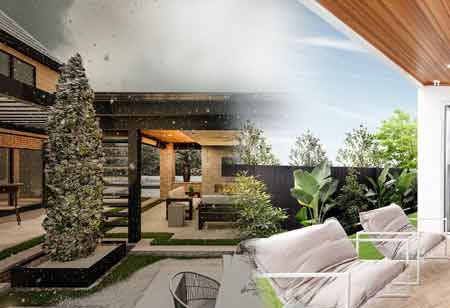Thank you for Subscribing to Construction Business Review Weekly Brief

Sustainable Practices for Modern Outdoor Living Spaces
The integration of indoor and outdoor spaces is gaining popularity due to sustainable alternatives like bamboo, cork flooring, recycled plastic lumber, and natural stone pavers.
The contemporary inclination towards seamlessly integrating indoor and outdoor spaces represents an increasingly prevalent design ethos. Patios, decks, and landscaped areas are now considered integral extensions of residential environments, fostering tranquil retreats that facilitate relaxation and a deeper connection with the natural world. Nonetheless, as this trend gains momentum, a concurrent obligation arises to imbue these havens with sustainable principles. Balancing aesthetic appeal with environmental consciousness is paramount in constructing and maintaining such spaces, ensuring their longevity and minimizing ecological impact.
Conventional reliance on pressure-treated wood, concrete, and vinyl has prompted a reconsideration of materials due to their notable environmental impact on outdoor living spaces. A shift towards sustainable alternatives has emerged, emphasizing eco-conscious choices. Renewable resources, exemplified by the rapid growth of bamboo, present a compelling substitute for traditional wood, offering exceptional strength, weather resistance, and a visually appealing natural aesthetic. Additionally, cork flooring stands as another eco-friendly option, ethically harvested from the bark of cork oak trees without causing harm to the tree itself.
Adopting a circular economy concept is gaining prominence within the construction industry, leading to innovative choices such as recycled plastic lumber. Crafted from post-consumer plastics, this material offers durability and low-maintenance attributes, particularly suitable for decking and fencing. The integration of reclaimed wood, sourced from old structures, imparts a rustic charm and also reduces demand for virgin timber.
A focus on nature's bounty is evident in pursuing sustainable outdoor design, with natural stone pavers emerging as a durable and timeless choice. While mindful quarrying practices are essential, using locally sourced stone further minimizes transportation emissions, aligning with a broader commitment to environmental responsibility in outdoor living space development.
The Commitment to Sustainable Practices
The industry's commitment to sustainability extends beyond mere material considerations, encapsulating a holistic approach that underscores eco-friendly practices. A notable facet of this commitment lies in the adherence to sustainable design principles, advocating for harmonious integration with the existing landscape.
This approach mitigates site disruption and diminishes the necessity for additional materials, such as retaining walls, while concurrently fostering natural drainage systems.
Furthermore, energy efficiency is emphasized through adopting outdoor lighting solutions powered by solar panels or low-voltage LED fixtures. This strategic utilization reduces dependence on the conventional grid and curtails overall energy consumption, contributing to a more sustainable and environmentally responsible operational framework.
The industry proactively engages in water conservation endeavors in tandem with these efforts. Incorporating drought-resistant plants and permeable pavers exemplifies a commitment to long-term water conservation objectives. These thoughtful choices allow rainwater to naturally filter back into the ground, mitigating water runoff and promoting a sustainable water management system.
Sustainability's Impact on Construction
Adopting sustainable choices throughout the construction process yields a positive ripple effect. This is evident in the reduced environmental footprint achieved by conscientious builders who opt for eco-friendly materials and practices, significantly lowering the project's carbon footprint and minimizing waste generation. Additionally, the emphasis on resource conservation through the utilization of renewable and recycled materials alleviates pressure on virgin resources, promoting a more sustainable future. Moreover, incorporating sustainable materials is associated with lower VOC (Volatile Organic Compound) emissions, fostering a healthier living environment indoors and outdoors. This holistic construction approach addresses immediate environmental concerns and enhances the overall well-being of occupants.
A Sustainable Future for Outdoor Living
The outdoor living industry is transforming towards a more conscientious ethos. Fueled by advancements in material science and a burgeoning consumer consciousness, sustainable alternatives are gaining prominence, offering both accessibility and cost-competitiveness. Embracing these eco-friendly principles enables the creation of outdoor environments that harmonize functionality and aesthetic appeal while demonstrating a commitment to planetary stewardship.








